Final report for SW18-041
Project Information
Consumer demand for broccoli has grown dramatically over the last 10 years and continues to expand. During that same 10-year period, Oregon broccoli production has dropped 33%. From a peak of more than 15,000 tons in 1987, only about 5,000 tons is expected to be processed in 2017. This reduction in acreage is the result of high labor costs associated with broccoli harvest. Many processed vegetable farms maintain crews of 3-5 workers but manual harvest requires crews of 9 or more. This project aims to develop a broccoli mechanical harvest system to reduce the number of harvest workers to 3–5. The project will scale up seed production of OSU-developed broccoli cultivars with exerted heads that are easily mechanically harvested, and it will evaluate the yield and processing quality of both OSU and commercial cultivars when grown with organic and conventional practices. It will evaluate the utility of selective seed harvest and seed processing to increase head maturation uniformity and facilitate single pass mechanical harvest. The project will support farmers in integrating a high school robotics team-developed visioning system into their farm-built harvesters. Because the demand for organic broccoli is growing, the project will also develop cost effective strategies to supply N from organic fertilizers, as broccoli is a high N demanding crop. This project should increase farm/farmer and processor economic sustainability as the result of increased broccoli production acreage and profitability. It should increase environmental sustainability by diversifying processed vegetable rotations and increasing organic and N-fixing cover crop acreage. It should increase the availability of US-grown broccoli to the consuming public as well as to public schools and federal institutions, resulting in a stronger and more nutritious national and regional food system and contributing to social sustainability.
Objective 1: Engage broccoli farmers in project development, delivery, results, and evaluation through the development of a farmer-led Broccoli Sustainability Task Force.
Objective 2: Evaluate available cultivars for mechanical harvest yield and processing quality under conventional and organic management and at varied planting densities
Objective 3: Describe and improve seed quality to improve maturation uniformity and facilitate single pass harvest
Objective 4: Engage farmers with a high school robotics team-developed harvester prototype to facilitate further development of inexpensive single pass mechanical broccoli harvesters
Objective 5: Develop cost effective organic broccoli fertilization regimes.
Cooperators
- - Producer
- - Producer
Research
Hypothesis for Obj. 2: (Evaluate available cultivars for mechanical harvest yield and processing quality under conventional and organic management and at varied planting densities): Broccoli cultivars will differ in traits associated with yield and processing quality when grown in different management systems.
Hypothesis for Obj. 3: (Describe and improve seed quality to improve maturation uniformity and facilitate single pass harvest): Seed quality can be manipulated to improve uniformity of maturity by separating based on size and density.
Hypothesis for Obj. 4: (Engage farmers with a high school robotics team-developed harvester prototype to facilitate further development of inexpensive single pass mechanical broccoli harvesters): A prototype machine can be built that will allow direct harvest of broccoli.
Hypothesis for Obj. 5: (Develop cost effective organic broccoli fertilization regimes): A cost effective broccoli fertilizer regime can be developed.
Objective 2:
Spring and fall replicated yield trials 2018 - 2019
Spring and fall replicated yield trials were established 2018. Transplants of hybrids were started in the greenhouse about May 1 (Spring trial) and July 10 (Fall trial). The spring trial was transplanted 7 June while the fall trial was planted 7 August. The spring trial consisted of four commercial cultivars (Cascadia, Emerald Pride, Monflor and Hancock) while the fall trial had the four commercial hybrids along with 16 OSU experimental hybrids. Hybrids were arranged one row plots 30 feet in length and replicated four times with in-row spacing of 12 inches. In addition to observation data, (including percent blind, head size, shape, firmness, exsertion, segmentation, uniformity, floret texture and color, and maturity) yield data was obtained. Heads from the plots were trimmed to a 6.5 inch length and weighed, after which leaves were stripped from the heads and heads were again weighed. Leaf percent was calculated from this data. Heads were sorted for those that were judged too young and small for the floretting process in the plant, and those that were culls (mostly too mature). A set of 10 heads were evaluated for diameter and hollow stem, and a subset of five heads was floretted and florets and stems weighed separately. Floret and stem weight data was used to calculate a floret:stem ratio. In the fall trial, the proportion of florets > 2.5 inches was also determined. Entries in the yield trial were taken to the OSU pilot processing plant for blanching and freezing. Frozen material was evaluated at the OSU winter cutting on 8 November and was displayed at the PNVA meetings in Kennewick, WA on 15 November 2018.
Data for the total net yield of broccoli harvested from several grower's field in 2018 was collected from the Yield and Grade reports generated by the Norpac vegetable processing plant. Calculations of per acre net yield for Cascadia and Emerald Pride varieties of broccoli was estimated from these grading reports. Only field sites which had a contiguous planting of each variety and similar agronomic inputs was used for the calculations of yield. The estimated per acre yield of total florets and usable sized florets (i.e. < 2.5 inches) was also calculated and extrapolated from the data collected during the fall replicated yield trial.
In 2019, a yield trial consisting of 12 entries (three check and nine experimental hybrids) was conducted in the summer and fall. The trial was seeded 05 July and transplanted 01 August. Experimental hybrid production focused on combining the OSU inbreds S471, S473 and S475 with others older and newer inbreds in the program. The trial was conducted as described for 2018 above, and with the same variables measured and procedures followed. Frozen material was evaluated at the OSU vegetable breeding program winter cutting on 8 November and was displayed at the PNVA meetings in Kennewick, WA on 15 November 2019.
Backcrossing of selected hybrids to place the nuclear genome in the Ogura and Arnund cytoplasmic male sterile (CMS) backgrounds continued. We focused mainly on the inbreds S454, S462, S463 and S473 but also intiated backcrossing to S471. Seed production of selected hybrid combinations and CMS backcrossing using a fertile inbred as a male and a CMS inbred as a female were evaluated in the field using six isolation plots (three at the Vegetable Research Farm, and three at the Lewis Brown Farm).
Broccoli heat trial and varietal evaluation
With the hot summers of 2017 and 2018 causing significant heat damage to heads during broccoli harvest, we decided to add an activity to screen broccoli cultivars for tolerance to heat. A broccoli heat and varietal evaluation trial was therefore conducted during the summer of 2019. The objective of the heat trial was to assess commercial hybrids and experimental breeding lines for suitability and overall tolerance to the climatic growing conditions commonly found in the Willamette valley. This refocusing of objectives to evaluating the climatic suitability of broccoli lines was determined to be necessary, as most commercially available cultivars are bred for production in mild and stable climatic regions such as the Salinas Valley in California. Temperature is often the main limiting factor in determining whether a broccoli variety can be grown successfully within a particular region, and mounting evidence of global climate change suggests the need for a more heat tolerant broccoli will only increase in the foreseeable future. From the perspective of commercial growers and farmers, heat tolerance alone does not make a broccoli variety suitable for large scale field plantings. More often than not, yield becomes of paramount concern for growers, while aspects of head quality and processing characteristics are the main concerns of the vegetable processors. In consideration of this, the research goals of Objective #2 became refocused upon identifying the broccoli hybrids which have the most complete range of desirable characteristics. From the perspective of farmers and the vegetable industry, such evaluations become what is necessary to ensure the long term viability of the broccoli industry in the Willamette Valley. We also considered it a plus if a cultivar had machine harvest plant architecture, but did not exclude any materials on this basis.
The heat trial was initiated by contacting known seed company representatives, examination of current online seed catalogues and collecting seeds from commercial broccoli lines which purportedly have heat adaptable traits. Contact with representatives of several major seed companies also yielded seeds from yet to be released lines of broccoli which were described as being tolerance to high temperatures environments. Cooperating universities and USDA breeders associated with the USDA-NIFA-SCRI funded Eastern Broccoli Project also sent seeds to be evaluated in this trial. With seeds from 38 broccoli lines having been collected (Table #1), the heat trial was designed to have six different planting dates spaced one week apart to maximize the potential range of temperature variability within a single growing season. Studies conducted by Bjorkman and Pearson (1998) have found there is likely a specific physiological period of time in a broccoli plant’s growth wherein excessive heat is the most detrimental to the formation of a broccoli head with desirable characteristics and quality. This 5-7 day period of time occurs when the broccoli plant is transitioning from vegetative growth into a reproductive phase, and the initial enlargement of bud primordia begins. Having six planting dates maximizes the potential of being able to correlate declines in plant performance with increases in ambient temperatures.
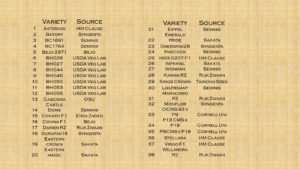 Table #1. List of broccoli cultivars selected for a heat trial.
Table #1. List of broccoli cultivars selected for a heat trial.
The seeding of each broccoli line was initiated inside the OSU campus greenhouses and approximately 4 weeks later transplanted into the field site at the University’s Vegetable farm in Corvallis. For each planting date, 15 seeds of each broccoli variety were started in seedling trays and the best 10 seedlings were then transplanted into the randomly assigned field plots using a transplanter (using one foot in-row placings). The six seeding dates were 10, 16, 23 & 30 May and 6 & 13 June. Two temperature data loggers were placed into the trial to record the ambient air temperatures at canopy height for the duration of the trial. The growth of broccoli and trial site was closely monitored for any IPM related issues and treated as necessary. Each head was harvested individually when it reached a prime stage of maturity and then evaluated for the criteria designated as being relevant to assessing the level of heat damage which occurred for that variety and planting. With each head being harvested individually, the number of days required to harvest a given planting can also estimate the cultivar's propensity for maturing uniformly. Evaluations of broccoli head quality consisted of rating each head for: color uniformity, bead uniformity, head uniformity, head firmness, and head diameter. With yield being of paramount concern for local broccoli farmers, the weight of each head (i.e. cut to 6.0in length), weight of total florets, and weight of usable florets (< 2.5in) was also incorporated into the evaluation criteria.
Objective 3:
Seed production in 2018 of selected hybrid combinations using a fertile inbred as a male and a CMS inbred as a female were evaluated in the field using six isolation plots (three at the Vegetable Research Farm, and three at the Lewis Brown Farm). Plots were at least a quarter mile apart. We started inbreds from rooted cuttings taken from flowering greenhouse-grown plants so that they would be flowering immediately upon establishment in the field. Cross combinations included O446/S454, O446/S462, O446/S471, O446/S473, O446/S475 and O462-1/S471. Parents were planted in 10 alternating rows approximately 20 ft. long with 12" within row spacing. Honeybees were the predominant pollinator species.
Seed fractioning study, OSU Seed Lab
A seed fractioning study was conducted in March of 2019, in conjunction with the OSU Seed Lab, to evaluate the effect of seed size and seed density on viability and vigor of broccoli seeds that are harvested from different canopy locations (e.g. top of plant vs. middle/bottom). Two genotypes were used in the study: 1) Cascadia, an OSU broccoli cultivar, and 2) experimental hybrid O462xS471. The O462xS471 hybrid seed was harvested from two locations in each plant: a) the top, and b) the middle and bottom combined. Therefore, three samples were evaluated, 1) Cascadia, 2) O462 xS471 (top), and 3) O462xS471 (middle/bottom) harvested seeds.
Seed size classification: The subsample designated for seed size was divided into three fractions:
- Large seeds,
- Medium seeds, and
- Small seeds.
Seed density classification: The subsample designated for seed density was divided into three fractions:
- Heavy weight,
- Mid weight, and
- Light weight
Seed Quality tests:
The quality of seeds of each classification was evaluated for viability and vigor using the following tests:
- Viability tests: Two seed viability tests were used to assess the viability of seeds in each classification of seeds: 1) standard germination test (SGT), and 2) tetrazolium test (TZ).
- Vigor tests: Two tests were used to assess seed vigor in each classification of seeds: 1) speed of germination index (SGI), and 2) accelerated aging test (AAT)
Maturation uniformity of field plantings using seed fractionings
Using the seed fractions collected from the study done by OSU's Seed lab, a field trial was planted at OSU's agricultural experiment station on May 23, 2019. The trial was designed to assess how uniform the maturation of broccoli heads would be within each size and density fractionation. The trial design was a RCB with three replications. Seeds from each fractionation group were planted into 20 ft plots using a hand-pushed belt planter. After emergence, plants were thinned to a 1ft spacing and grown to maturity with standard agronomic inputs. The uniformity of maturation was assessed by rating individual heads of each research plot for maturity level, using a visual scoring system with a scale of 0 - 7 (Figure #1). This maturation evaluation was conducted on a calendar date when the entire field was deemed to be suitable for a one time harvest, simulating usage of a non-selective mechanical harvester. A score of "5" was given to heads at a prime state of maturity. Heads given a score of 4 or 6 were considered as having "acceptable maturity" at the processing plant, although not the most ideal.
After careful monitoring of the developmental stages of broccoli heads within the field site, a maturity evaluation was conducted on August 2nd for the entire trial. It was soon after determined that Cascadia variety of broccoli has a slightly longer field season than the O462xS471 hybrid, so a second evaluation was conducted 10 days later (Aug 12) on only the Cascadia plots.
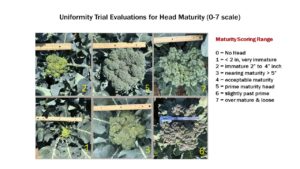 Figure #1 -Visual summary of broccoli head maturity rating system.
Figure #1 -Visual summary of broccoli head maturity rating system.
Objective 4:
Prototype broccoli harvester
A new prototype broccoli harvester was developed and built by the Crescent Valley FIRST Robotics Team 955 in 2018. Cascadia was seeded and transplanted at approximately two week intervals at the OSU Vegetable Research Farm to provide a continuous supply of broccoli for harvest testing by the "BroccoliBot". This system was deployed to the field at the OSU Vegetable Research Farm (Figure #2) and later during the season, in farmers' fields (Figure #3).
The Crescent Valley FIRST Robotics Team 955 developed and built a sixth prototype broccoli harvester in 2019. This prototype continued the incremental development of using a camera-based vision system to identify and locate broccoli in three-dimensional space. The prototype further developed the mechanical portion of field harvesting, specifically addressing whether the vision system could be adapted to allow a mechanical harvester to selectively harvest broccoli that is mature, while leaving immature broccoli untouched to continue growing.
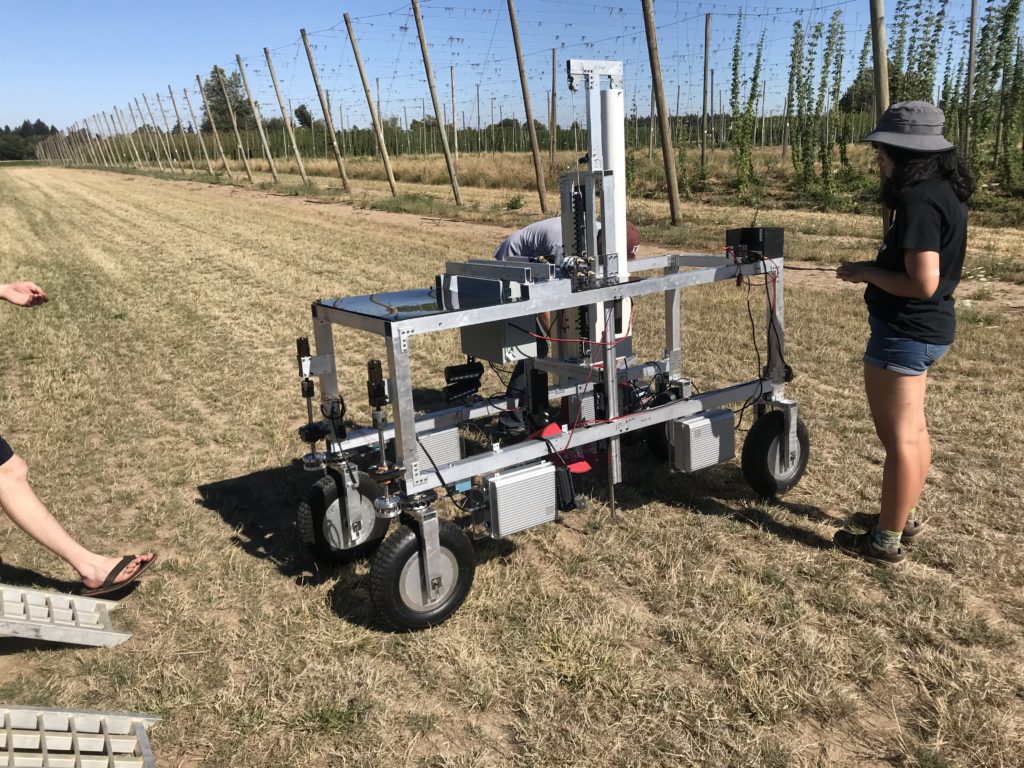 Figure #2. "BroccoliBot" prototype broccoli harvester, OSU Vegetable Research Farm, 2018.
Figure #2. "BroccoliBot" prototype broccoli harvester, OSU Vegetable Research Farm, 2018.
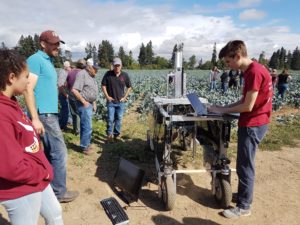 Figure #3. "BroccoliBot" field day demonstration, Pearmine farm, 2018.
Figure #3. "BroccoliBot" field day demonstration, Pearmine farm, 2018.
Objective 5:
Organic broccoli fertilization regimes
Broccoli has one of the greatest demands for N of any vegetable crop with > 180 lbs N needed from the 4-leaf stage to harvest. Organic growers usually apply N (from organic fertilizer, cover crop residue, or compost) before seeding or transplanting, using N rate guidance developed for conventional broccoli production. This research was conducted to determine the efficacy of a specialty organic fertilizer (feather meal; 12-0-0) in supplying plant-available N for broccoli, and to determine the relationship between mid-season soil nitrate analyses (0-30 cm) broccoli head yield and biomass N uptake.
Crop and soil response to feather meal application was compared to that of urea applied at the same rates and timings. Fertilizers were applied at rates of 0, 60, 120, and 180 lbs N per acre via preplant broadcast or sidedress application (4-6 leaf stage). Sidedress fertilizer treatments were applied by hand in a furrow 5-8 cm deep and 5-8 cm beside the row. Split fertilizer application (60 lbs N per acre preplant + 60 lbs N per acre sidedress) was also evaluated. (Table #2).
Two experiments were conducted in successive years in small plots within the same field (Newberg sandy loam; 23 g kg-1 SOM in 0-30 cm depth). Prior to our trials, the field was conventionally fertilized for 5+ yr. Subplots were 2.7 x 7.6 m in a randomized complete block design with 4 replications. 'Cascadia' was seeded and thinned to 32,600 plants per acre. Soil samples for nitrate analysis were collected between rows at 0-30 and 30-60 cm depth at 40 d after seeding (4-6 leaf stage).
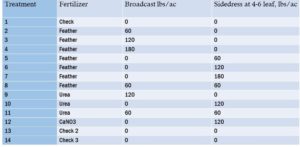 Table #2. Broccoli fertilizer treatments and rates.
Table #2. Broccoli fertilizer treatments and rates.
Non-fertilizer N contributions were monitored by buried bag and irrigation sampling:
Buried Bag
To assess the in situ nitrogen mineralization potential of the untreated plots, a composite soil sample was taken before planting from several areas of the trial and placed into 16 polyethylene sleeves/bags. These bags were then reburied in the field, and incubated for 3, 6, 9, and 12 weeks. Four bags from each incubation timing was then retrieved, with a subsample sent to a laboratory and analyzed for soil inorganic N content. The N mineralization potential of the untreated soil was then calculated as the difference between each successive incubation period and the total inorganic N (nitrate + ammonium) content taken from the initial sample (i.e. at Week 0).
Irrigation Water and Soil Temperature Monitoring
Nitrate levels commonly found in irrigation water have been known to provide a substantial amount of plant-available nitrogen to crops. Therefore measurements of the nitrate concentration of the irrigation water were assessed for N inputs and taken into account as N credit for the crop. The microbial activity that mediates mineralization of organic N is known to speed up when soil is warm and moist, and conversely slow down when the soil is cold or dry. To assess the potential seasonal fluctuations related to soil temperature at various depths, HOBO data loggers were buried at 3, 6, 9 and 12 inches at the trial site.
Harvest Yield
Yield data was collected by harvesting broccoli heads from approximately 16.4 feet of length from the middle row of the four replicated plots for each treatment. Only heads that had reached a commercially acceptable standard of maturity were harvested for processing of yield parameters. Broccoli harvesting took place over the course of three days in a similar manner to hand harvesting which is done in commercial broccoli fields (i.e. to accommodate the non-uniform maturation of crop). Leaves were removed from the stems and head and stems were cut to 7 inch lengths before individual weights were taken on heads.
Dry matter biomass and N uptake
After final harvest, three whole broccoli plants from the center row of each treatment plot was cut at soil level, weighed and then shredded in a wood chipper. An approximately 1 kilogram subsample of the shredded biomass was then oven dried at 130 degrees F, with the resulting dry matter weight recorded and sent to a commercial laboratory for analysis of nitrogen content.
Objective 2:
Spring and fall replicated yield trials 2018 - 2019
Spring yield trial. Of the four commercial hybrids trialed in 2018 (Cascadia, Emerald Pride, Monflor and Hancock), all but Emerald Pride have the exserted head trait, but varied for other traits such as head segmentation, color, bead size and yield. In terms of Net yield, Cascadia, Monflor and Emerald Pride were not significantly different (4.1 - 4.6 T/A), but were significantly lower yielding than Hancock (8.9 T/A). Emerald Pride had the most leaves on the stem (22%) followed by Monflor (20%) with Cascadia (12%) and Hancock (7%). Hancock had a significantly greater percent florets compared to the others (70% vs. 56 - 61%), a high percentage of florets were > 2.5” that would require recutting in the plant. Cascadia had the best combination of quality traits followed by Emerald Pride. Of the commercial hybrids, Monflor has very deep branching and would require stems to be cut to a very long length to keep the head intact for floretting in the plant.
Fall yield trial: Yields were about 3 T/A lower than in the spring. Hancock had the highest Net T/A at 6.0 but the differential was not as great compared to other hybrids, which ranged from 3.3 to 5.4 T/A. Most OSU experimental hybrids did not have yield significantly different from Monflor and Emerald Pride. Cascadia had the lowest net yield at 3.3 T/A. It had the highest leave percentage (10.6%) suggesting that it was cut at a younger developmental stage than the others. Percent florets ranged from 59.2 to 77.1% while usable florets ranged from 42.3 to 56.2%. While Hancock had the highest percent florets, it had the second to lowest usable florets. Emerald Pride ranked fourth from the bottom for usable florets while Cascadia was in the middle of the group and Monflor had the second highest percent usable florets. On a T/A basis, Hancock had the second highest weight (following Monflor and Emerald Pride) of usable florets, while Cascadia had the lowest. A number of OSU experimental hybrids were not significantly different from Monflor and Hancock. The lesson learned is that overall head weight is more important than proportion of the head that is made up of florets.
A heavy aphid infestation was observed in this trial and number of heads with aphid damage was recorded. Significant differences in aphid infestation were observed with some of the lowest numbers being for the four commercial hybrids. Among experimentals, S474/S446 had relatively low numbers.
Production of the first hybrid of O446xS454 was initiated and became the first OSU commerical broccoli release named Cascadia. The seed yield from winter production successfully met targets, and in summer of 2018, and over 300 acres of Cascadia were grown and harvested for processing on commercial farms in Oregon. Seeds from this production were also distributed for use in seed grade testing and density trials for the 2018 growing season (obj. 3). After yield and quality results of the 2018 growing season came in from the grower’s fields and the processor, Cascadia was dropped from commercial production in favor of other commercial varieties, none of which are bred specifically for mechanical harvest, but have better total yields.
Grower's yield data in 2018 for Cascadia and Emerald Pride broccoli from four field sites in the Willamette Valley is shown below. Head yields for Cascadia and Emerald Pride were similar in two paired fields but Cascadia had lower yields in two other fields (Figure #4). Floret yield showed a similar pattern (Figure #5), as did usable (<2.5in.) floret yield (Figure #6). Overall, Cascadia and Emerald Pride have similar yield potential, but Cascadia seems to be more variable over environments. Cascadia had fewer leaves on heads, better floret size and more uniform floret color.
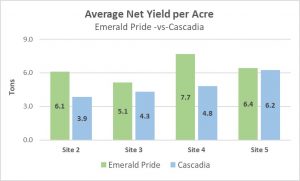 Figure #4. Per acre net yield of broccoli heads
Figure #4. Per acre net yield of broccoli heads
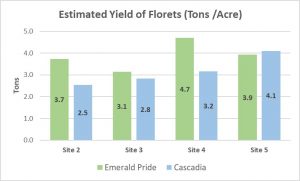 Figure #5. Total broccoli head floret yield
Figure #5. Total broccoli head floret yield
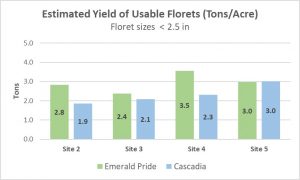 Figure #6. Usable broccoli head floret yield
Figure #6. Usable broccoli head floret yield
In the 2019 yield trial, yields ranged from 4 to 6.8 T/A (net) with Imperial and Emerald Pride checks having the highest yields, but there was no statistically significant difference among entries in the trial. Three OSU experimental broccoli hybrids had similar yields to existing commercial hybrids, but had more desirable characteristics for processing. We measured floret:stem ratio and usable floret (<2.5”) proportion and while Imperial had the highest floret weight, only about 43% were usable as is and would not need to be recut. In general as yield increased, floret size also increased. S471 does seem to combine well to produce high yields and has favorable quality attributes when combined with some older OSU inbreds.
Broccoli heat trial and varietal evaluation
Of the 38 broccoli cultivars planted for the 2019 heat trial (Figure #7), most of the broccoli hybrids had some form or combination of detrimental qualities observed within the 6 plantings. The most common of these detrimental qualities being irregularities in bead size and lack of uniformity in head color and shape (Figure #8). These irregularities were the most common symptom of a broccoli head having been affected by high temperatures. Several of the experimental broccoli cultivars showed tolerance to temperature variations, but did not produce commercially viable yields at harvest. Other broccoli cultivars that produced high quality heads in all 6 plantings were considered to be impractical for commercial use because of unfavorable characteristic traits such as poor floret sizes or lack of head exsertion.
Several commercial lines did perform reasonably well across the given environmental conditions created by having six plantings dates, and scored high in most of the evaluation criteria. A summary table of the 23 most successful broccoli lines trialed, and how they performed within each evaluation criteria can be seen in Table #3 & 4. Some of these broccoli hybrids were previously described as being tolerant to heat, and originated from established commercial seed companies. The 15 lines of broccoli not included in Table #3 did not meet the threshold of success as defined for the trial to be considered as top candidates for planting in the Willamette Valley. The issues commonly associated with these lines could generally be categorized as: 1). showing classic symptoms of heat affected head development (e.g. Maracaibo, HMX 0207, Stellara, Greenpak28, Covina), or 2). did not produce reasonable yields (Monflor, Bejo 2971 BH025, BH026, BH044, BH045, P13CMSxP19, P8CMSxP19). It should be noted that the BH series were inbreds so would be expected to be lower yielding, but might have potential when used in hybrid combinations.
 Table #4. Description of evaluation criteria used for heat trial summary chart above.
Table #4. Description of evaluation criteria used for heat trial summary chart above.
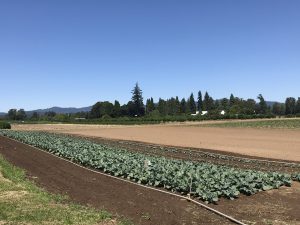 Figure #7. Heat trial field site, as seen on July 25th, 2019.
Figure #7. Heat trial field site, as seen on July 25th, 2019.
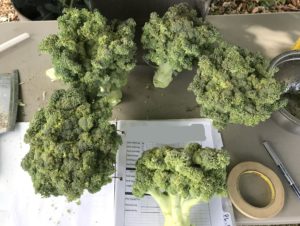 Figure #8. Symptoms of heat damage affecting broccoli heads.
Figure #8. Symptoms of heat damage affecting broccoli heads.
Objective 3:
In 2018 Seed production from isolation plots was variable and ranged from 31 seeds (O446/S471) to over 3000 seeds for O446/S473 and well over 5,000 seeds for O462-1/S471. S462-1/S471 was harvested from three levels on the plants to approximate seed produced early- mid- and late-season.
Seed fractioning study, OSU Seed Lab
Effect of Seed Size on viability and vigor of Cascadia and O462xS471 genotype
Cascadia: Difference in seed size did not affect seed viability of Cascadia as measured by the standard germination test and the TZ test. The germination percentage of Cascadia was 98%, 98%, and 97% for large, medium and small seeds, respectively. The seed viability by TZ test of Cascadia was 100%, 99%, and 99% for large, medium and small seeds, respectively. The viability of the Cascadia undivided control sample was 99% by both germination and TZ tests.
Difference in seed size did not affect seed vigor of Cascadia as measured by the speed of germination index (SGI) and the accelerated aging test (AAT). The SGI were 32.5, 32.5, and 32.2 for large, medium and small seeds, respectively. The SGI of the control sample was 32.9. The AAT results were 95%, 92%, and 93% for large, medium and small seeds, respectively. The AAT result of the control sample was 95%.
O462xS471 hybrid (Figure #9): Both large and medium seeds, whether harvested from the top or from the middle/bottom part of the plants, had similar germination percentage, ranging between 95% and 92%, whereas the germination of the small seeds harvested from the top and from the mid/bottom parts of the plants ranged from 86% to 80%. The O462xS471 control sample that was not divided by size or density had a germination percentage of 95% for seeds that were harvested from the top of the plants and 91% for seeds that were harvested from the mid/bottom plants.
Similar results were obtained when the TZ test was used to evaluate seed viability. The viability of large and medium seeds harvested from the top and from the middle/bottom plants raged from 99% to 96%. The viability of small seeds harvested from the top and from the mid/bottom parts of the plants was 88% and 73%, respectively. Difference in germination and viability by TZ of large and medium seeds and between the germination and viability of the control sample was not significant according to the AOSA Tolerance Tables 14K of the Rules for Testing Seeds (AOSA, 2018).
In seed vigor assessment of O462xS471, small seeds that were harvested from either the top or the middle/ bottom parts of the plants had significantly lower SGI than the large and medium seeds (13.7 vs. 12.6). Both large and medium seeds, whether harvested from the top or from the middle/bottom part of the plants had similar SGI, ranging from 29.2 to 30.8. The SGI of the control sample was 30.2, which was not significantly different from large or medium seeds harvested from either the top or the mid/bottom of the plants.
Small seeds that were harvested from either the top or the middle/ bottom parts of the plants had significantly lower AAT results than the large and medium seeds (45% and 82%, respectively). The AAT results of large and medium seeds harvested from the top of O462xS471 were 95% and 97%, respectively. The AAT results of seeds from the mid/bottom parts of the plants were significantly lower than the seeds from the top at 86% for large seeds and 76% for medium seeds.
The 0462xS471 control sample that was not divided by size or density had AAT result of 90% for seeds that were harvested from the top part of the plants, and was 87% from seeds that were harvested from mid/bottom part of the plants.
These results confirmed that small seeds of O462xS471 had significantly lower germination and viability compared to the medium and larger seeds. However, both large and medium seeds had similar germination and viability levels, whether seeds were harvested from the top or from the mid/bottom part of the plants.
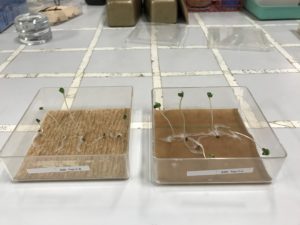 Figure #9. O462xS471 hybrid seeds being evaluated for viability and vigor.
Figure #9. O462xS471 hybrid seeds being evaluated for viability and vigor.
Effect of seed density on seed viability and vigor of Cascadia and O462xS471 broccoli hybrids
Cascadia: Difference in seed density did not affect seed viability of Cascadia as measured by the standard germination test and the TZ test. The germination percentage of Cascadia was 99%, 99%, and 98% for heavy, middle and light seeds, respectively. The viability by TZ was 99%, 99%, and 96% for heavy, middle and light seeds, respectively. The viability of Cascadia control sample that was not divided by density was 99% by both germination and TZ tests. These results suggest that seed density did not affect the viability of Cascadia. Similarly, difference in seed density did not affect seed vigor of Cascadia as measured by the speed of germination index (SGI) and the accelerated aging test (AAT). The SGI were 32.9, 32.8, and 32.4 for heavy, middle and light seeds, respectively. The SGI of the control sample was 32.9. The AAT results were 94%, 88%, and 90% for heavy, middle and light seeds, respectively. The AAT result of the control sample was 95%
O462xS471: Both heavy and middle density seeds, whether harvested from the top or from the middle/bottom part of the plants, had similar germination percentage. The germination percentage of heavy and middle seeds harvested from the top and from the middle/bottom plants ranged between 99% and 94%, whereas the germination of the light seeds harvested from the top and from the mid/bottom parts of the plants ranged between 73% and 72%. Similar results were obtained when the TZ test was used to evaluate seed viability. The seed viability of heavy and middle seeds harvested from the top and from the middle/bottom plants ranged between 100% and 98%, whereas the viability of the light seeds harvested from the top and from the mid/bottom parts of the plants ranged between 80% and 77%.
The O462xS471 control sample that was not divided by size or density had a germination percentage of 95% for seeds that were harvested from the top of the plants and 91% for seeds that were harvested from the mid/bottom plants. These results confirmed that light seeds of O462xS471 had significantly lower germination and viability compared to the middle and heavy seeds, whether seeds were harvested from the top or the mid/bottom parts of the plants. Both middle and heavy seeds had similar germination and viability levels.
In seed vigor assessment of O462xS471, light seeds that were harvested from either the top or the middle/ bottom plants had significantly less SGI than the heavy and middle seeds at 22.7 and 21.9, respectively. Both heavy and middle seeds, whether harvested from the top or from the middle/bottom part of the plants, had similar SGI, ranging from 30.0 to 31.3. The SGI of the control sample was 30.2, which was not significantly different from large or medium seeds harvested from either the top or the mid/bottom of the plants.
Light seeds that were harvested from either the top or the middle/ bottom parts of the plants had significantly less AAT results than the large and medium seeds at 74% and 52%, respectively. The AAT results of heavy and middle seeds harvested from the top part of O462xS471 plants were 95% and 96%, respectively. The AAT results of seeds from the mid/bottom parts of the plants were significantly less than the seeds from the top at 91% for large seeds and 88% for middle seeds. The O462xS471 control sample that was not divided by size or density had AAT result of 90% for seeds that were harvested from the top pat of the plants, and was 87% from seeds that were harvested from mid/bottom part of the plants.
These results confirmed that light seeds of 0462xS471 had significantly lower germination and viability compared to the heavy and middle seeds. However, both heavy and middle seeds had similar SGI levels, whether seeds were harvested from the top or from the mid/bottom part of the plants. Seed vigor as measured by the AAT test was relatively better in seeds harvested from the top part of the plants compared to those harvested from the mid/bottom part of the plants
Maturation uniformity of field plantings using seed fractionings
The results for the uniformity field trial's plantings can be seen below in Figures #10, #11, & #12. The Y axis of Density can be understood as % of the total # as a decimal. For example, the treatment Cascadia_small sized seed fractionation had 44% of the all heads rated as a "5" (i.e. prime maturity) on the day of evaluation, August 12th.
The two bar graphs below (Figures #13 and #14) show what proportion (%) all of the broccoli heads were at for each maturity classification on the day of evaluation. These two bar graphs are added to demonstrate that on the day selected for evaluations of head maturity (e.g. a speculative mechanical harvesting), most of the heads were at a prime state of maturity (e.g. 37% for Cascadia, and 30% for the O642xS471 hybrid).
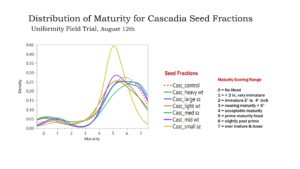 Figure #10. Distribution of broccoli head maturity for Cascadia seed fractions.
Figure #10. Distribution of broccoli head maturity for Cascadia seed fractions.
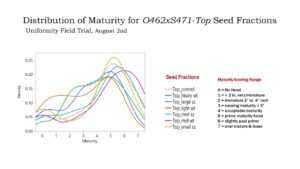 Figure #11. Distribution of broccoli head maturity for O462xS471-Top seed fractions.
Figure #11. Distribution of broccoli head maturity for O462xS471-Top seed fractions.
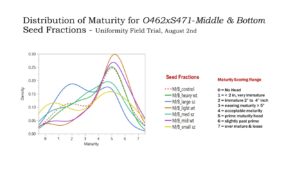 Figure #12. Distribution of Broccoli head maturity for O462xS471-Mid & Bottom seed fractions.
Figure #12. Distribution of Broccoli head maturity for O462xS471-Mid & Bottom seed fractions.
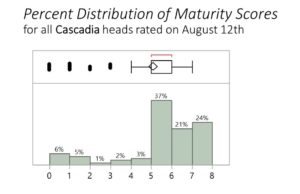 Figure #13. Distribution of maturity scores for all Cascadia broccoli heads on Aug 12th.
Figure #13. Distribution of maturity scores for all Cascadia broccoli heads on Aug 12th.
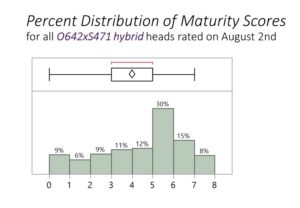 Figure #14. Distribution of maturity scores for all O642xS471 broccoli heads on Aug 2nd.
Figure #14. Distribution of maturity scores for all O642xS471 broccoli heads on Aug 2nd.
Objective 4:
Prototype broccoli harvester
In 2018, the BroccoliBot prototype continued with the development of using a camera-based vision system to identify and locate broccoli in three-dimensional space. The prototype further developed the mechanical portion of field harvesting, specifically addressing whether the vision system could be adapted to allow a mechanical harvester to cut florets in the field rather than whole broccoli heads. This prototype was field tested over the course of the summer at the OSU research farm first, and there-after in multiple commercial farms. The camera-based vision system has demonstrated reliability, but the mechanical portion of the harvester was not successful in consistent cutting of florets in the field. Adjustable blade angles would help in this regard. The mechanical harvesting system was discussed at length with growers, and was the focus of improvements in 2019.
In 2019 the modification of the prototype involved two significant steps. The first was the development of a mechanical harvesting mechanism capable of harvesting individual broccoli crowns to allow multipass operations. The second was the creation of software code capable of identifying mature broccoli, and also software capable of adjustment to determine what constitutes immature broccoli needing to be left in the field. The team had a temporary version of code that arbitrarily determined an ideal sized head, but the final code target was one which used 'deep learning', essentially artificial intelligence to compare known broccoli images to the observed field and make a 'judgement' as to which broccoli are to be harvested. While not completely functional the vision/software expert system was successful and confirmed that this was the way to go to ensure the harvester's technology is forward thinking and adaptable in the future. These two accomplishments were added to a new prototype that was completed at the end of the fall of 2019. This prototype was not finished in time for field testing in the 2019 growing season. The prototype was to be demonstrated in field testing in the 2020 season along side the previous prototype capable of single-pass complete harvest of broccoli florets.
Objective 5:
Organic broccoli fertilization regimes
Broccoli was efficient in extracting N from the soil. Yield from 2019 season trial can be seen in Figure #15 and Table #4. With zero N fertilizer applied, above ground biomass contained 134-150 lbs N per acre at harvest. With N fertilization, above ground crop N uptake reached a maximum of 223 lbs N per acre in both years. In 2018, head yield did not respond to fertilization (data not shown). In 2019, head yield was maximized with 120 lbs N per acre (Figure #15). Midseason soil nitrate increased linearly with preplant feather meal rate. Midseason nitrate-N was 30+ ppm (0-30 cm depth) with preplant feather meal N application of 60 lbs N per acre (2018), and with 120 lbs N per acre (2019). Within N rates, head yield and biomass N uptake were generally equivalent for preplant or sidedress N application.
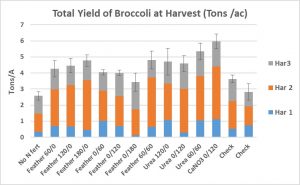 Figure #15. Broccoli yields for each fertilizer treatment in 2019 (T/Acre)
Figure #15. Broccoli yields for each fertilizer treatment in 2019 (T/Acre)
 Table #4. Means table of broccoli yield at harvest, 2019 in a fertilizer trial.
Table #4. Means table of broccoli yield at harvest, 2019 in a fertilizer trial.
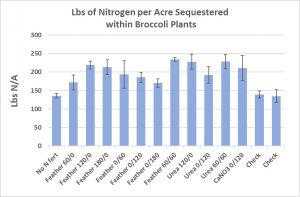 Figure #16. Nitrogen uptake of broccoli plants, 2019 (Lbs/Acre).
Figure #16. Nitrogen uptake of broccoli plants, 2019 (Lbs/Acre).
Soil laboratory analysis also determined a summary of post harvest ammonium (NH4+) and nitrate (NO3+) levels in soil samples taken at 1ft and 2ft depths in the field, and can be seen in Figures #17 and #18 (below).
Objective 2:
Broccoli hybrid yield trials
From various yield trials on station and in farmers' fields over the two years, no new hybrid was found that was sufficiently better to displace the most widely used Emerald Pride. Some hybrids were higher yielding but did not possess quality attributes, while others had superb processing quality but did not achieve high and stable yields. This was observed in particular with the OSU release Cascadia, which in some environments, had equivalent yields to Emerald Pride, but in other environments, did worse than the check cultivar. Some of the newer hybrids and particularly those that use the inbred S471 show promise in producing higher yields and good processing qualities. The OSU breeding program needs to incorporate higher yielding germplasm as well as heat tolerant materials. It is also apparent that higher yields are achieved through increases in floret size as shown by the percentage of florets greater than the processor idea of 2.5 in. in higher yielding cultivars. It will be a challenge to increase yields while keeping florets to a manageable size.
Broccoli Heat trial and varietal evaluation
Considerable variation was observed among broccoli cultivars for tolerance to heat damage as well as yield. Since no broccoli can be considered the perfect variety for all occasions, and all climates, selecting the best cultivar for growing in western Oregon depends upon production objectives. Growers may consider yield as the main determining factor for variety selection, but this may be at the expense of quality important for processing. The two highest yielding broccoli hybrids grown in the heat trial were also the lowest scoring in quality. Conversely, the most aesthetically appealing broccoli heads came from hybrids that lacked significant total yields at harvest. Some broccoli hybrids originating from Sakata and Seminis seed companies performed well even during mid summer heat and consistently produced acceptable yield but did not necessarily have the quality traits required for processing. The two cultivars with consistent performance across the season, had heads of high quality and acceptable yields were Kings Crown (Tainong Seed) and Asteriod (HM Clause). None of the OSU hybrids with exserted heads bred for mechanical harvest had acceptable yields although some were of exceptional quality. A major objective of the OSU broccoli breeding program should be incorporating heat tolerance and head size into the mechanically harvestable ideotype.
For those seeking more detail on the heat trial, below is a hyperlink to photos of all 38 lines of broccoli grown for this trial. Also included in this folder: 1) a PowerPoint presentation from Scott Lukas' program at Hermiston Agricultural Research & Extension Center, who grew the same 38 lines in the much hotter climatic conditions of Eastern Oregon during the same year. 2) Excel file calculations of total head yield and total floret yield of each line and 3) climate and temperature data collected from data loggers placed at the trial site for the duration of this trial
https://oregonstate.box.com/s/4z3zsz9mj8hdeg8c0cl7aggv971v1hhd
Objective 3:
Seed fractioning study, OSU Seed Lab
The results of this study showed that all fractions of Cascadia that were separated by seed size or density had similar viability and vigor. Therefore, no separation by seed size or density is recommended for Cascadia. In general, Cascadia seeds had excellent viability and vigor traits. On the other hand, small and light seeds of O462x5471 hybrid had less viability and vigor than large/medium, and middle/heavy seeds. Seeds harvested from the top part of the plant had better seed viability and vigor than seeds harvested from the middle/bottom of the plant. This is somewhat counterintuititve in that we would have expected seeds from the middle and bottom portions of the plant to have set earlier, and to have reached maturity earlier than seeds from the top of the plant. Overall, it appears that seed viability and vigor based on size or weight is genotype-specific.
Objective 4:
Prototype broccoli harvester
The vision system for the "BroccoliBot" was successfully developed to recognize broccoli heads and adjust harvest equipment for automated broccoli harvest. The mechanical side of the harvest operation had more challenges but such was not unexpected in a prototype.
As an update to the 2020 season, the prototype was intended to be field tested in 2020, but was completed due to COVID-19 restrictions placed on the team by the Oregon Department of Education. Despite the restrictions which prevented in person meetings, the team did manage to individually meet and move development forward. In laboratory conditions the prototype demonstrated the ability to autonomously and selectively harvest broccoli. However the prototype remains unfinished and not yet ready for field testing. The camera-based vision system has demonstrated that it is technical feasible to accomplish selective mechanical harvest with an autonomous harvester without a labor crew. The reality is that the prototype work completed by the robotics team is a successful innovation in need of further development to become fully commercialized. A utility patent has been filed on the visioning system.
Objective 5:
Organic broccoli fertilization regimes
Overall, we observed similar crop and soil response to N input from feather meal or urea. Crop yield was maximized and crop N use efficiency was high when N was applied at a rate of 120 lbs N per acre or less. Feather meal N mineralized to nitrate-N rapidly, and so could be useful as a sidedress N fertilizer if provided in a suitable form for commercial application. Broccoli head yield was maximized when midseason soil nitrate-N values were > 30 ppm in 0-30 cm depth.
Research Outcomes
Education and Outreach
Participation Summary:
OBJECTIVE 1: Engage broccoli farmers in project development, delivery, results, and evaluation through the development of a farmer-led Broccoli Sustainability Task Force.
The Task Force has been active for more than 3 years and developed this project. The task force formally met n winter 2019. During the production season, the task force coordinated:
1a Demonstration Field Day of mechanical harvester at Pearmine Farms – August 13th, 2018.
1b. Broccoli breeding variety display table at Pacific Northwest Vegetable Association conference -November 14th & 15th 2018; November 20, 2019.
- and also displayed at OSU food technology building on November 8th 2018, & November 8th 2019.
1c. Touring of the processing plant in Brooks OR.
1d. Field Demonstration of the robotic harvester at Pearmine farms in Brooks, Oregon.
1e. Field testing of the robotic harvester on the OSU research farm.
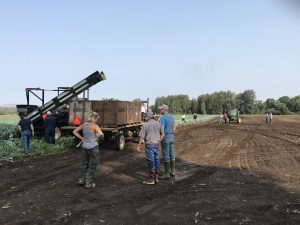
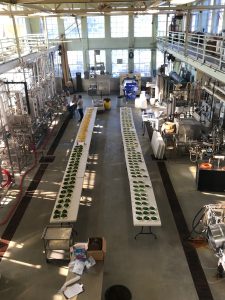
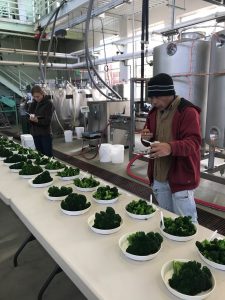
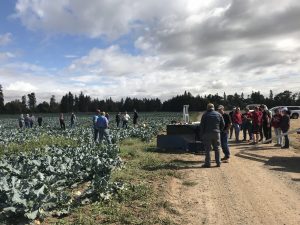
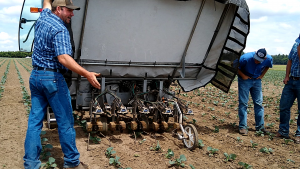 (left) Mechanical weeder field day and demo, June 3rd, 2019
(left) Mechanical weeder field day and demo, June 3rd, 2019
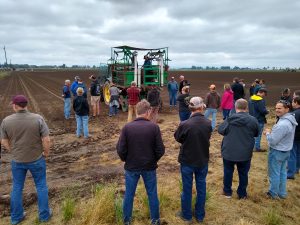 (left) Mechanical tape transplanter demo day for broccoli , May 23rd, 2019
(left) Mechanical tape transplanter demo day for broccoli , May 23rd, 2019
Education and Outreach Outcomes
- The importance of large scale field plantings to evaluate on-farm performance of new varieties before release
- How new varieties of broccoli are bred, and how this process can lead to new varieties with adaptions to a wider range of climatic variations and better uniformity
- Performance of new OSU lines in comparison to current commercial lines of broccoli
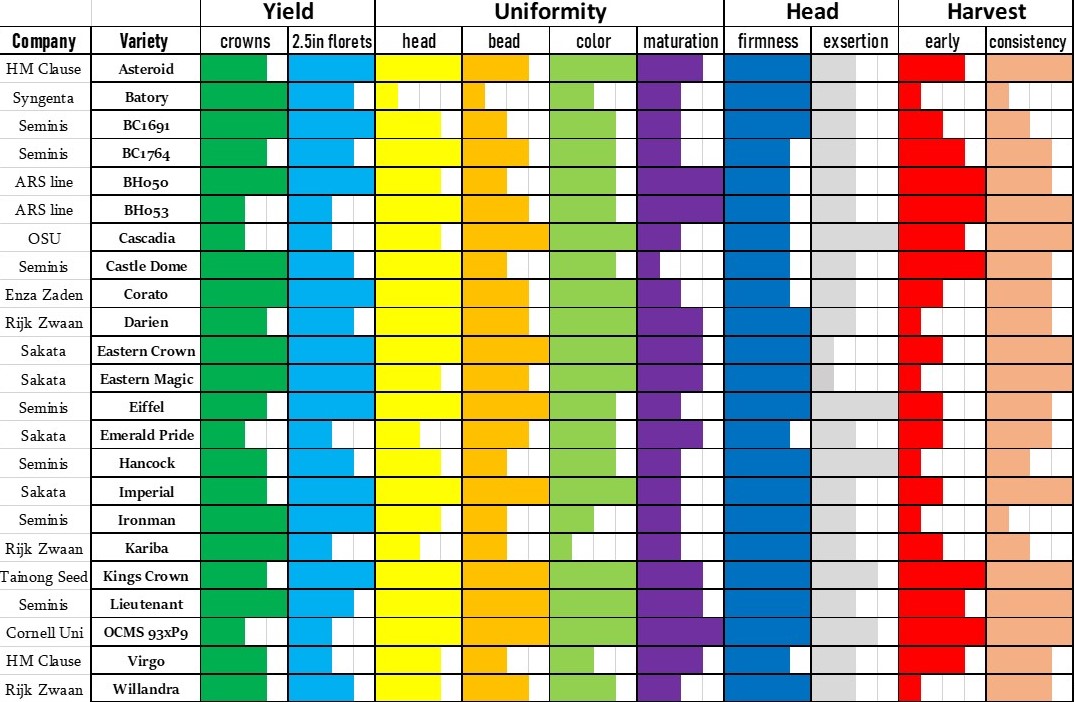 Table #3. Summary chart of the top 23 top performing commercial and experimental broccoli cultivars in a heat trial.
Table #3. Summary chart of the top 23 top performing commercial and experimental broccoli cultivars in a heat trial.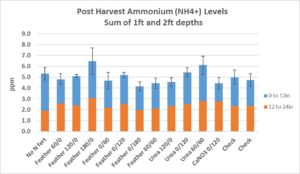 Figure #17. Post-harvest levels of ammonium in the soil at 1ft and 2ft depths from a broccoli fertilizer trial.
Figure #17. Post-harvest levels of ammonium in the soil at 1ft and 2ft depths from a broccoli fertilizer trial.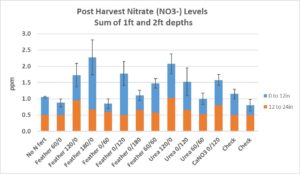 Figure #18. Post-harvest levels of nitrate in the soil at 1ft and 2ft depths from a broccoli fertilizer trial.
Figure #18. Post-harvest levels of nitrate in the soil at 1ft and 2ft depths from a broccoli fertilizer trial.